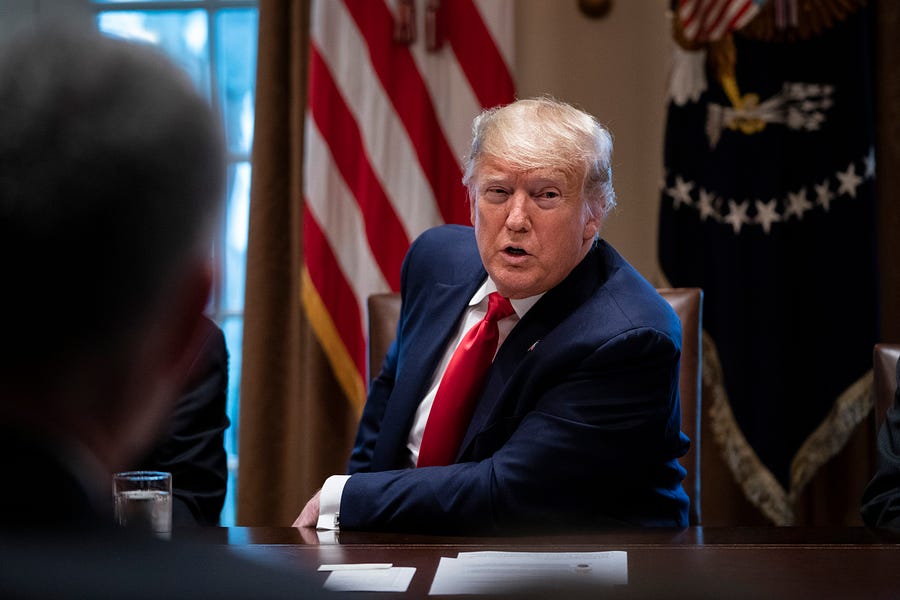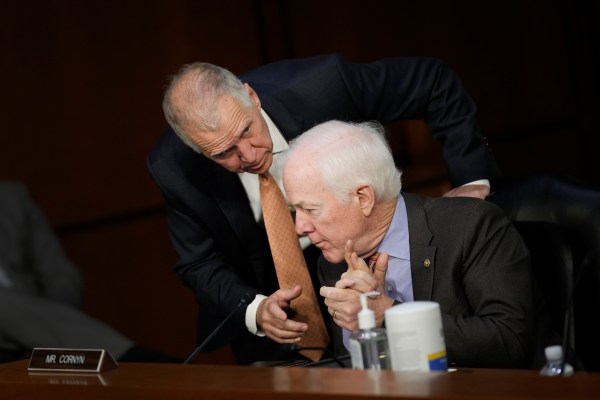If you need more evidence that nobody knows what’s really going to happen with the coronavirus outbreak, look no further than the last few days’ wild stock-market roller coaster. After slumping through the second half of February, markets have been flailing wildly so far in March, leaping and diving at an alarming rate.
It’s understandable that President Trump isn’t thrilled by all this market chaos. But he responded Monday by suggesting once again that coronavirus concerns are blown out of proportion—stoking experts’ fears that he is leading his supporters to underestimate the virus’s threat. In a tweet, the president compared coronavirus to the seasonal flu and noted that “life & the economy go on” during flu season.
It’s not hard to see why things like the coronavirus tanking U.S. markets get under Trump’s skin: He’s obsessed with keeping up appearances, and he bristles at being blamed for things he considers outside his own control. It’s the same outlook that was on display in a strange comment about a quarantined cruise ship he made during a visit to the Centers for Disease Control in Atlanta, saying he’d prefer infected passengers stay aboard because “I don’t need to have the numbers double because of one ship that wasn’t our fault.”
At this point, it’s still impossible to know just how far off-base it is to compare the severity of novel coronavirus to the seasonal flu. And Trump has had a point in the past that the virus may prove less deadly than early estimates feared: Doctors are hopeful that the ultimate mortality rate will drop from the current World Health Organization estimate of 3.4 percent, which many experts believe is high, to below 1 percent. But a number of experts told The Dispatch Monday that even if mortalities end up far below that number, the virus still poses an extraordinary threat to the U.S. health care system—one which will require a serious collective effort on the part of the American people to avert.
Let’s deal with the most obvious point first. It’s true that seasonal flu has thus far killed far, far more Americans than has the coronavirus—because the coronavirus has not yet become a real pandemic among the American people. If it does begin transmitting through American cities and communities in numbers approaching those of, say, the 2009 swine flu, even more conservative fatality metrics suggest far more Americans would die than they do in a year from the annual flu.
“About 61 million Americans were infected with the swine flu, which was the most serious flu epidemic we’ve had in recent times,” Dr. Howard Forman, a radiology and health policy professor at Yale, told The Dispatch. “The CDC estimates that 12,000 people died. So that’s a 0.02 percent [fatality rate].”
By contrast, the latest fatality numbers from places with mass testing like South Korea peg the coronavirus at a death rate of about 0.7 percent: Lower than previously estimated, but “at best 35 times more lethal” than the swine flu epidemic, Forman added.
Those numbers are bracing, but they fail to really capture the entirety of the threat the coronavirus represents, and why it risks being so disruptive.
Why is it that, as Trump says, “life & the economy go on” despite tens of thousands of annual flu deaths? Primarily because the seasonal flu is, well, seasonal. Hospitals and medical centers know roughly how much of it to expect each year, and they’re able to plan accordingly. Many people die, yes, but that’s rarely due to a lack of sufficient medical resources or care.
A sudden epidemic of something like the coronavirus, by contrast, is impossible to plan for. At any given time, especially during flu season, most hospitals are already operating near their peak capacity for diseased patients. Operating under the assumption that a mass outbreak is always right around the corner just isn’t economically feasible in many places.
Thus, in addition to the medical battle against the disease—figuring out the best treatment methods, developing vaccines, and the like—sudden epidemics present health care providers with a huge logistical challenge as well: figuring out how to suddenly scale up their space, inventory, and staff to meet the sudden demand.
One Northern Virginia doctor, who has been coordinating coronavirus response for his practice and asked to be quoted anonymously to speak candidly, put it this way: “The big concern among everybody right now is that in a couple weeks’ time—this virus notably has a very delayed onset of some of the more severe symptoms—that we won’t be able to have the capacity, especially of intensive care units, but even hospital beds in general, to be able to get people the support that they need to get through this.”
This sort of strain on the health care system might manifest itself in a number of ways, some obvious and some subtle. The most obvious potential danger is that hospitals wouldn’t have enough resources to treat critically ill coronavirus sufferers, thanks to a shortage of, say, ventilators. But such a situation would see substantial downstream effects too, even for patients with health issues completely unrelated to the outbreak.
“That’s what’s giving most health care providers the most concern,” Dr. Megan Ranney, an emergency physician who teaches at Brown University, told The Dispatch. “It’s not necessarily the mortality rate of this particular virus, as it is the fact that we’re going to have a lot of people exposed to a virus they’ve never seen before. And if that exposure happens really quickly, our emergency departments and hospitals face the risk of being overwhelmed. And then we won’t be able to take care of the people having the regular illnesses, like heart attacks and strokes and appendicitis. We will already be at capacity.”
Other than strict containment of the virus—and it’s looking more and more like that train has left the station—the key factor that will determine how severe this problem becomes is time. This is where having a bought-in populace factors in. All the active measures doctors are recommending to help stop the spread of the disease—avoiding large gatherings, beefing up personal hygiene, staying home if you start to feel sick—won’t only help diminish the total number of Americans who catch the coronavirus. Just as importantly, such measures help to slow the advance of the disease, spreading the load of cases over a longer and more manageable period of time. The more conscientious Americans are about this, the less risk of hospitals being overwhelmed by sudden spikes.
This is one of the big reasons why it’s important even for people who aren’t among its high-risk populations to remain scrupulous about the coronavirus. The other is obvious: The best thing a person can do to prevent the elderly and people with dangerous complicating conditions from catching the illness is to do everything he can not to catch and spread it himself.
All this has been made more difficult, of course, by the slow and uneven rollout of early testing efforts from the federal government. “There’s a lot that I don’t understand about what happens at the highest levels of the FDA or the CDC,” the Virginia doctor said. “But just speaking pragmatically as a physician on the ground, I can’t excuse the fact that we’ve had months to prepare and we’re behind places like South Korea and China.” But those we talked to all said that, rather than dwell on such past mistakes, the most critical task going forward is to ensure the public is educated and on the same page. Which brings us back to President Trump.
“I think the fault of the president is messaging,” Forman said. “The CDC thing, it’s anybody’s guess how bad or how much of a screw-up that is, and whether it has anything to do with politics whatsoever. It’s a screw-up, but I don’t look at that as failed leadership. The failed leadership is the communication piece: The lack of transparency and the bad, bad messaging, which quite frankly continues today.”
“If he were to step up and say with a common voice that this is very serious—I take every person’s life very seriously, and we’re going to do everything we can to stamp it out, and we’re committing every resource to it—and if he were to sit still and not say anything else, that would be reassuring to people. But he’s constantly messaging like this isn’t a big deal.”
There’s no denying that it’s possible to fall off the bus the other direction: to veer from an unhealthy nonchalance about the outbreak to an unhealthy sense of panic. We’ve seen evidence of that error in recent days too, as with the run on the nation’s supply of medical masks that has left even hospital workers suddenly facing the possibility of a shortage. A good portion of that is doubtless attributable to clumsy or sensational coverage of the disease in the media. And too much fear could end up having the same system-paralyzing effects as not enough concern, as University of Pennsylvania vaccinologist Dr. Paul Offit argued on the “Doctor Radio” XM radio channel Monday: “I think that the reason people are so scared is they think this virus is uniquely capable of killing them. … I think we’ve done a bad job of how we’ve educated the public about this because we’ve scared them to death, and I just think we’re doing more harm than good. I worry that we’re going to overwhelm our health care systems because of fear of this virus, and thus deny resources to people who really do need it.”
The bottom line is this: If the coronavirus takes off here, how well we get through the next few months will depend in large part on the spirit in which the American people approach the problem. And for better or worse, no single American wields more influence over that spirit than President Trump. It remains to be seen whether he’ll use his influence to help rally each of us to make the common sense decisions that might save lives—or to squander that influence with unceasing squabbling about who’s to blame for the problem in the first place.
Photograph of Donald Trump by Drew Angerer/Getty Images.






Please note that we at The Dispatch hold ourselves, our work, and our commenters to a higher standard than other places on the internet. We welcome comments that foster genuine debate or discussion—including comments critical of us or our work—but responses that include ad hominem attacks on fellow Dispatch members or are intended to stoke fear and anger may be moderated.
With your membership, you only have the ability to comment on The Morning Dispatch articles. Consider upgrading to join the conversation everywhere.